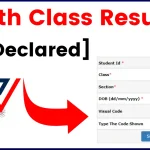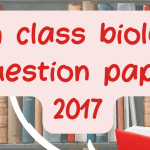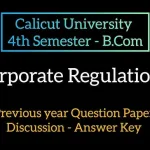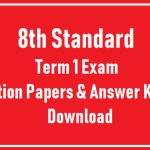Here are sample kendriya vidyalaya question papers class 8 2019 for all subjects. The syllabus includes subjects like English, Hindi, Mathematics, Science, and Social Science.
Sample Question Papers with Answers for Kendriya Vidyalaya Class 8th for Year 2019
English
1. Question: Write an essay on “The Importance of Reading Books.”
Answer: Reading books is crucial as it develops the mind, improves concentration, enhances knowledge, and provides entertainment. It broadens one’s perspective and helps in developing empathy. Additionally, reading improves language skills and vocabulary.
2. Question: What are the main themes in the story “The Best Christmas Present in the World”?
Answer: The main themes include the horrors of war, the importance of peace and goodwill, and the power of human connection. The story emphasizes the impact of kindness and the hope for a better future.
3. Question: Explain the significance of the poem “Geography Lesson.”
Answer: The poem “Geography Lesson” highlights the interconnectedness of the world and the insignificance of human conflicts from a broader perspective. It teaches that geographical boundaries should not divide humanity.
4. Question: Summarize the story “The Tsunami.”
Answer: “The Tsunami” recounts the experiences of people during and after a tsunami. It focuses on survival, loss, and the resilience of the human spirit. The story highlights the unpredictability of natural disasters and the importance of preparedness.
5. Question: What lesson do we learn from the story “A Short Monsoon Diary”?
Answer: The story teaches us to appreciate the beauty of nature and the changing seasons. It also emphasizes the importance of observation and reflection in understanding the world around us.
6. Question: Describe the character of Mr. Lamb in “On the Face of It.”
Answer: Mr. Lamb is a kind and optimistic man who, despite his disability, lives a full and content life. He teaches Derry to look beyond physical appearances and find joy in simple things.
7. Question: What is the central message of the poem “The Ant and the Cricket”?
Answer: The central message is the value of hard work and preparation. The poem contrasts the industrious ant with the carefree cricket, highlighting the consequences of their choices.
8. Question: Discuss the significance of the title “The Last Leaf.”
Answer: The title “The Last Leaf” symbolizes hope and survival. The last leaf painted by Behrman represents his sacrifice and the hope it gives to Johnsy, motivating her to fight for her life.
9. Question: What are the major themes in the story “This is Jody’s Fawn”?
Answer: The major themes include compassion, responsibility, and the bond between humans and animals. The story illustrates Jody’s caring nature and his sense of duty towards the fawn.
10. Question: Explain the moral of the story “The Treasure Within.”
Answer: The moral is that everyone has unique talents and strengths. The story encourages readers to recognize and nurture their abilities, regardless of societal expectations or academic success.
Hindi
1. प्रश्न: संतोष यादव की जीवनी का संक्षेप में वर्णन कीजिए।
उत्तर: संतोष यादव एक पर्वतारोही हैं जिन्होंने दो बार माउंट एवरेस्ट पर चढ़ाई की है। उनका जन्म हरियाणा के एक छोटे से गाँव में हुआ था और उन्होंने कठिन परिश्रम और दृढ़ निश्चय से यह मुकाम हासिल किया।
2. प्रश्न: ‘डायरी का एक पन्ना’ पाठ में लेखक ने किस घटना का वर्णन किया है?
उत्तर: ‘डायरी का एक पन्ना’ में लेखक ने अपनी बचपन की एक घटना का वर्णन किया है जब उन्होंने पहली बार स्कूल जाने का अनुभव किया और वहां के अनुभवों ने उन्हें जीवन भर के लिए प्रभावित किया।
3. प्रश्न: ‘हमारी हिंदी’ पाठ में हिंदी भाषा के क्या-क्या महत्त्व बताए गए हैं?
उत्तर: ‘हमारी हिंदी’ पाठ में हिंदी के महत्त्व को राष्ट्रीय एकता, संस्कृति और साहित्य के माध्यम से उजागर किया गया है। यह भाषा भारत की विभिन्नता में एकता का प्रतीक है।
4. प्रश्न: ‘कबीर की साखियाँ’ का मुख्य संदेश क्या है?
उत्तर: ‘कबीर की साखियाँ’ में मुख्य संदेश है कि जीवन में सत्य, प्रेम और ईश्वर के प्रति आस्था का पालन करना चाहिए। कबीर ने सामाजिक कुरीतियों और आडंबरों की आलोचना की है।
5. प्रश्न: ‘नमक का दारोगा’ कहानी में वंशीधर के चरित्र का वर्णन कीजिए।
उत्तर: वंशीधर एक ईमानदार और कर्तव्यनिष्ठ व्यक्ति है। वह अपने कर्तव्य के प्रति इतना समर्पित है कि रिश्वत के रूप में दी गई बड़ी राशि को भी ठुकरा देता है।
6. प्रश्न: ‘माता का आँचल’ कहानी का मुख्य पात्र कौन है और उसकी विशेषताएँ क्या हैं?
उत्तर: ‘माता का आँचल’ का मुख्य पात्र बालक मोहन है। उसकी विशेषताएँ हैं मासूमियत, जिज्ञासा और माता के प्रति गहरी श्रद्धा।
7. प्रश्न: ‘चिट्ठियों की अनूठी दुनिया’ पाठ में लेखक ने क्या संदेश दिया है?
उत्तर: ‘चिट्ठियों की अनूठी दुनिया’ में लेखक ने संदेश दिया है कि चिट्ठियाँ हमारी भावनाओं और विचारों को व्यक्त करने का एक महत्वपूर्ण माध्यम हैं और यह हमें अपने प्रियजनों के साथ जोड़ती हैं।
8. प्रश्न: ‘दादी माँ’ कविता का सारांश लिखिए।
उत्तर: ‘दादी माँ’ कविता में कवि ने अपनी दादी की यादों और उनके साथ बिताए पलों को संजोया है। यह कविता दादी के स्नेह, अनुभव और उनकी महत्वपूर्ण सीखों का वर्णन करती है।
9. प्रश्न: ‘पृथ्वी हमारा घर’ पाठ का मुख्य विचार क्या है?
उत्तर: ‘पृथ्वी हमारा घर’ पाठ में मुख्य विचार है कि हमें अपनी पृथ्वी की सुरक्षा और संरक्षण के लिए जागरूक होना चाहिए और इसके प्राकृतिक संसाधनों का सही उपयोग करना चाहिए।
10. प्रश्न: ‘एक फूल की चाह’ कविता का मुख्य संदेश क्या है?
उत्तर: ‘एक फूल की चाह’ कविता में मुख्य संदेश है कि जीवन में सादगी और संतोष महत्वपूर्ण है। एक फूल की चाह व्यक्ति को सच्ची खुशी और आंतरिक शांति देती है।
Mathematics
1. Question: Solve x+3=7x + 3 = 7.
Answer: x=4x = 4.
2. Question: What is the formula for the area of a trapezium?
Answer: The area of a trapezium is given by Area=12×(a+b)×h\text{Area} = \frac{1}{2} \times (a + b) \times h, where aa and bb are the lengths of the parallel sides, and hh is the height.
3. Question: Find the value of 5×(3+2)5 \times (3 + 2).
Answer: 5×(3+2)=5×5=255 \times (3 + 2) = 5 \times 5 = 25.
4. Question: What is the volume of a cube with side length 4 cm?
Answer: The volume of the cube is 43=644^3 = 64 cubic cm.
5. Question: Simplify 8+2×38 + 2 \times 3.
Answer: 8+2×3=8+6=148 + 2 \times 3 = 8 + 6 = 14.
6. Question: Solve for yy in 2y−3=52y – 3 = 5.
Answer: 2y−3=52y – 3 = 5 2y=82y = 8 y=4y = 4.
7. Question: Calculate the perimeter of a rectangle with length 8 cm and width 5 cm.
Answer: The perimeter is 2×(8+5)=2×13=262 \times (8 + 5) = 2 \times 13 = 26 cm.
8. Question: What is the value of 34+23\frac{3}{4} + \frac{2}{3}?
Answer: 34+23=912+812=1712=1512\frac{3}{4} + \frac{2}{3} = \frac{9}{12} + \frac{8}{12} = \frac{17}{12} = 1 \frac{5}{12}.
9. Question: Find the square root of 81.
Answer: The square root of 81 is 9.
10. Question: If the angles of a triangle are in the ratio 2:3:4, find the measure of each angle.
Answer: Let the angles be 2x,3x,2x, 3x, and 4x4x. 2x+3x+4x=180∘2x + 3x + 4x = 180^\circ 9x=180∘9x = 180^\circ x=20∘x = 20^\circ So, the angles are 40∘,60∘,40^\circ, 60^\circ, and 80∘80^\circ.
Science
1. Question: Explain the process of photosynthesis.
Answer: Photosynthesis is the process by which green plants use sunlight, carbon dioxide, and water to produce glucose and oxygen. The chemical equation for photosynthesis is: 6CO2+6H2O+light energy→C6H12O6+6O26CO_2 + 6H_2O + \text{light energy} \rightarrow C_6H_{12}O_6 + 6O_2.
2. Question: What is the role of the stomach in the human digestive system?
Answer: The stomach secretes digestive enzymes and acids that break down food into a semi-liquid form called chyme. It also churns the food to mix it with digestive juices for better digestion.
3. Question: Define and give an example of a chemical change.
Answer: A chemical change is a process where substances transform into new substances with different properties. Example: Rusting of iron.
4. Question: What are the three states of matter? Give an example of each.
Answer: The three states of matter are solid (ice), liquid (water), and gas (water vapor).
5. Question: Explain the water cycle.
Answer: The water cycle is the continuous movement of water on, above, and below the surface of the Earth. It includes processes such as evaporation, condensation, precipitation, and collection.
6. Question: What is the difference between renewable and non-renewable resources? Give examples.
Answer: Renewable resources can be replenished naturally over time, such as solar and wind energy. Non-renewable resources are finite and cannot be replenished quickly, such as coal and oil.
7. Question: Describe the structure of an atom.
Answer: An atom consists of a nucleus containing protons and neutrons, with electrons orbiting around the nucleus in electron shells.
8. Question: What are the effects of deforestation on the environment?
Answer: Deforestation leads to loss of biodiversity, disruption of water cycles, soil erosion, and contributes to climate change by increasing carbon dioxide levels in the atmosphere.
9. Question: What is the function of the heart in the circulatory system?
Answer: The heart pumps blood throughout the body, supplying oxygen and nutrients to tissues and removing carbon dioxide and other wastes.
10. Question: Explain Newton’s third law of motion with an example.
Answer: Newton’s third law states that for every action, there is an equal and opposite reaction. Example: When you push against a wall, the wall pushes back with an equal and opposite force.
Social Science
1. Question: What was the significance of the Battle of Plassey?
Answer: The Battle of Plassey in 1757 marked the beginning of British colonial rule in India. The victory allowed the British East India Company to establish control over Bengal and expand their influence.
2. Question: Describe the main features of the Indian Constitution.
Answer: The Indian Constitution includes features such as a parliamentary system of government, federal structure, fundamental rights, directive principles of state policy, and an independent judiciary.
3. Question: What is the importance of the Himalayas in India?
Answer: The Himalayas act as a natural barrier protecting India from cold winds and invasions. They are the source of major rivers, contribute to the monsoon climate, and support diverse ecosystems and biodiversity.
4. Question: Explain the concept of sustainable development.
Answer: Sustainable development refers to meeting the needs of the present without compromising the ability of future generations to meet their own needs. It emphasizes the balanced use of resources, environmental protection, and social equity.
5. Question: What were the causes and effects of the Non-Cooperation Movement?
Answer: The Non-Cooperation Movement was launched by Mahatma Gandhi in 1920 to resist British rule through non-violent means. Causes included the Jallianwala Bagh massacre and repressive British policies. Effects included widespread boycott of British goods and institutions, and increased nationalistic fervor.
6. Question: Describe the climatic conditions of the Thar Desert.
Answer: The Thar Desert experiences extreme temperatures with hot summers and cold winters. It has low annual rainfall, leading to arid and semi-arid conditions, with sparse vegetation.
7. Question: What are the major industries in India?
Answer: Major industries in India include information technology, textiles, automotive, pharmaceuticals, and agriculture-based industries.
8. Question: Explain the impact of globalization on the Indian economy.
Answer: Globalization has led to increased trade, foreign investment, and economic growth in India. It has also brought technological advancements and improved infrastructure, but has also posed challenges such as income inequality and cultural changes.
9. Question: What is the role of the Reserve Bank of India?
Answer: The Reserve Bank of India (RBI) regulates the country’s monetary policy, manages currency issuance, oversees the banking system, and works to maintain financial stability.
10. Question: Explain the significance of the Quit India Movement.
Answer: The Quit India Movement, launched in 1942, was a mass protest demanding an end to British rule in India. It mobilized millions of Indians, leading to widespread demonstrations and eventually contributed to India gaining independence in 1947.
All about kendriya vidyalaya and class 8th question papers for 2019 year
The Kendriya Vidyalaya Class 8 question papers for 2019 were meticulously crafted to provide a balanced assessment of students’ knowledge and skills across various subjects. By understanding the structure and key focus areas of these papers, students can prepare more effectively and perform better in their exams.
Structure and Format
The Class 8 question papers of Kendriya Vidyalaya in 2019 were structured to cover a wide range of topics across different subjects. Each paper was designed to test both the theoretical understanding and practical application of concepts. The question papers typically included multiple-choice questions (MCQs), short answer questions (SAQs), and long answer questions (LAQs). The distribution of marks was balanced to ensure comprehensive assessment across all sections.
Subject-wise Breakdown
1. English
The English paper aimed to evaluate students’ proficiency in language, comprehension, grammar, and writing skills. Key sections included:
- Reading Comprehension: Passages followed by questions to assess understanding and interpretation.
- Grammar: Questions on tenses, prepositions, conjunctions, and other grammatical aspects.
- Writing: Essays, letters, and paragraph writing to gauge creativity and coherence.
- Literature: Questions based on the prescribed textbook, including poetry, prose, and drama.
2. Hindi
The Hindi question paper was designed to test language skills, comprehension, and literature knowledge. Major sections were:
- अपठित गद्यांश (Unseen Passage): Comprehension questions based on unseen passages.
- व्याकरण (Grammar): Questions on Sandhi, Samas, Muhavare, and other grammatical topics.
- लेखन (Writing): Essay writing, letter writing, and story writing.
- साहित्य (Literature): Questions based on the prescribed textbook content.
3. Mathematics
The Mathematics paper focused on problem-solving abilities and conceptual understanding. Key topics included:
- Algebra: Linear equations, exponents, and algebraic expressions.
- Geometry: Properties of triangles, quadrilaterals, and circles.
- Mensuration: Questions on the area, volume, and surface area of various shapes.
- Data Handling: Interpretation and representation of data using graphs and charts.
4. Science
The Science paper aimed to evaluate students’ understanding of scientific principles and their application. Major sections included:
- Physics: Topics like force, pressure, friction, and light.
- Chemistry: Questions on materials, substances, and chemical reactions.
- Biology: Concepts related to the human body, plants, and ecosystems.
- Practical Skills: Questions based on lab experiments and scientific reasoning.
5. Social Science
The Social Science paper was designed to assess knowledge of history, geography, and civics. Key sections were:
- History: Questions on significant historical events and figures.
- Geography: Topics like resources, environment, and geographical phenomena.
- Civics: Understanding of political systems, democracy, and governance.
- Map Work: Questions involving map reading and interpretation.
Preparation Tips
- Understand the Syllabus: Thoroughly go through the syllabus and identify key topics for each subject.
- Practice Previous Papers: Solving past question papers helps in understanding the pattern and difficulty level.
- Focus on Weak Areas: Identify and work on subjects or topics where improvement is needed.
- Time Management: Practice managing time effectively during exams to ensure all questions are attempted.
- Regular Revision: Consistent revision of important concepts and formulas is crucial for retention.
Latest Posts
- Aai La Birthday Wishes In Marathi
- UKG English Question Paper PDF
- Class 12 Computer Science Notes
- Pharmaceutical Microbiology 3rd Sem Notes
- Sant Gadge Baba Amravati University Question Paper
- Beautiful Marathi Birthday Wishes For Aai And Brother
- Collection of 2 Line Sad and Heart Touching Shayari
- Mahadev Shayari 2 Line
- Thiruvalluvar University PG Question Paper
- M Letter Names For Girl In Tamil






